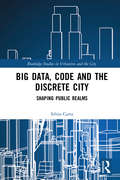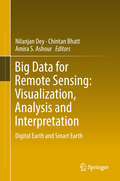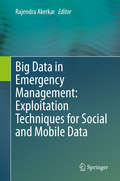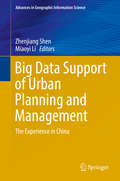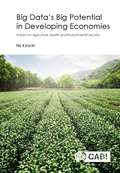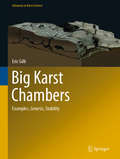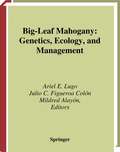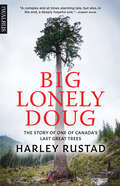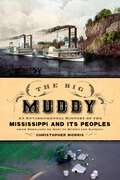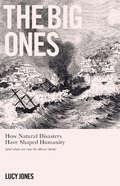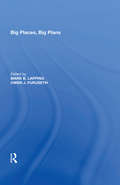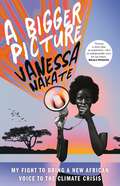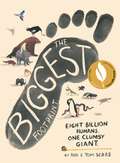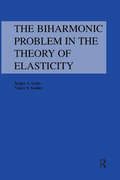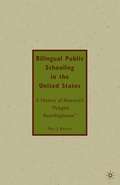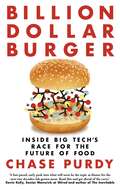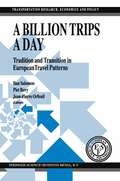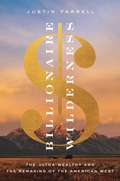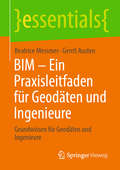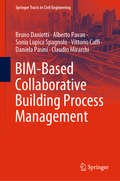- Table View
- List View
Big Data, Code and the Discrete City: Shaping Public Realms (Routledge Studies in Urbanism and the City)
by Silvio CartaBig Data, Code and the Discrete City explores how digital technologies are gradually changing the way in which the public space is designed by architects, managed by policymakers and experienced by individuals. Smart city technologies are superseding the traditional human experience that has characterised the making of the public space until today. This book examines how computers see the public space and the effect of algorithms, artificial intelligences and automated processes on the human experience in public spaces. Divided into three parts, the first part of this book examines the notion of discreteness in its origins and applications to computer sciences. The second section presents a dual perspective: it explores the ways in which public spaces are constructed by the computer-driven logic and then translated into control mechanisms, design strategies and software-aided design. This perspective also describes the way in which individuals perceive this new public space, through its digital logic, and discrete mechanisms (from Wi-Fi coverage to self-tracking). Finally, in the third part, this book scrutinises the discrete logic with which computers operate, and how this is permeating into aspects of city life. This book is valuable for anyone interested in urban studies and digital technologies, and more specifically in big data, urban informatics and public space.
Big Data, Code and the Discrete City: Shaping Public Realms (Routledge Studies in Urbanism and the City)
by Silvio CartaBig Data, Code and the Discrete City explores how digital technologies are gradually changing the way in which the public space is designed by architects, managed by policymakers and experienced by individuals. Smart city technologies are superseding the traditional human experience that has characterised the making of the public space until today. This book examines how computers see the public space and the effect of algorithms, artificial intelligences and automated processes on the human experience in public spaces. Divided into three parts, the first part of this book examines the notion of discreteness in its origins and applications to computer sciences. The second section presents a dual perspective: it explores the ways in which public spaces are constructed by the computer-driven logic and then translated into control mechanisms, design strategies and software-aided design. This perspective also describes the way in which individuals perceive this new public space, through its digital logic, and discrete mechanisms (from Wi-Fi coverage to self-tracking). Finally, in the third part, this book scrutinises the discrete logic with which computers operate, and how this is permeating into aspects of city life. This book is valuable for anyone interested in urban studies and digital technologies, and more specifically in big data, urban informatics and public space.
Big Data for Remote Sensing: Digital Earth and Smart Earth
by Nilanjan Dey Chintan Bhatt Amira S. AshourThis book thoroughly covers the remote sensing visualization and analysis techniques based on computational imaging and vision in Earth science. Remote sensing is considered a significant information source for monitoring and mapping natural and man-made land through the development of sensor resolutions that committed different Earth observation platforms. The book includes related topics for the different systems, models, and approaches used in the visualization of remote sensing images. It offers flexible and sophisticated solutions for removing uncertainty from the satellite data. It introduces real time big data analytics to derive intelligence systems in enterprise earth science applications. Furthermore, the book integrates statistical concepts with computer-based geographic information systems (GIS). It focuses on image processing techniques for observing data together with uncertainty information raised by spectral, spatial, and positional accuracy of GPS data. The book addresses several advanced improvement models to guide the engineers in developing different remote sensing visualization and analysis schemes. Highlights on the advanced improvement models of the supervised/unsupervised classification algorithms, support vector machines, artificial neural networks, fuzzy logic, decision-making algorithms, and Time Series Model and Forecasting are addressed. This book guides engineers, designers, and researchers to exploit the intrinsic design remote sensing systems. The book gathers remarkable material from an international experts' panel to guide the readers during the development of earth big data analytics and their challenges.
Big Data in Emergency Management: Exploitation Techniques for Social and Mobile Data
by Rajendra AkerkarThis contributed volume discusses essential topics and the fundamentals for Big Data Emergency Management and primarily focusses on the application of Big Data for Emergency Management. It walks the reader through the state of the art, in different facets of the big disaster data field. This includes many elements that are important for these technologies to have real-world impact. This book brings together different computational techniques from: machine learning, communication network analysis, natural language processing, knowledge graphs, data mining, and information visualization, aiming at methods that are typically used for processing big emergency data. This book also provides authoritative insights and highlights valuable lessons by distinguished authors, who are leaders in this field.Emergencies are severe, large-scale, non-routine events that disrupt the normal functioning of a community or a society, causing widespread and overwhelming losses and impacts. Emergency Management is the process of planning and taking actions to minimize the social and physical impact of emergencies and reduces the community’s vulnerability to the consequences of emergencies. Information exchange before, during and after the disaster periods can greatly reduce the losses caused by the emergency. This allows people to make better use of the available resources, such as relief materials and medical supplies. It also provides a channel through which reports on casualties and losses in each affected area, can be delivered expeditiously. Big Data-Driven Emergency Management refers to applying advanced data collection and analysis technologies to achieve more effective and responsive decision-making during emergencies.Researchers, engineers and computer scientists working in Big Data Emergency Management, who need to deal with large and complex sets of data will want to purchase this book. Advanced-level students interested in data-driven emergency/crisis/disaster management will also want to purchase this book as a study guide.
Big Data Support of Urban Planning and Management: The Experience in China (Advances in Geographic Information Science)
by Zhenjiang Shen Miaoyi LiIn the era of big data, this book explores the new challenges of urban-rural planning and management from a practical perspective based on a multidisciplinary project. Researchers as contributors to this book have accomplished their projects by using big data and relevant data mining technologies for investigating the possibilities of big data, such as that obtained through cell phones, social network systems and smart cards instead of conventional survey data for urban planning support. This book showcases active researchers who share their experiences and ideas on human mobility, accessibility and recognition of places, connectivity of transportation and urban structure in order to provide effective analytic and forecasting tools for smart city planning and design solutions in China.
Big Data’s Big Potential in Developing Economies: Impact on Agriculture, Health and Environmental Security
by Nir KshetriBig data involves the use of sophisticated analytics to make decisions based on large-scale data inputs. It is set to transform agriculture, environmental protection and healthcare in developing countries. This book critically evaluates the developing big data industry and market in these countries and gives an overview of the determinants, performance and impacts. It provides a detailed analysis of technology creation, technology infrastructures and human skills required to utilize big data while discussing novel applications and business models that make use of it to overcome healthcare barriers. The book also offers an analysis of big data's potential to improve environmental monitoring and protection where it is likely to have far-reaching and profound impacts on the agricultural sector. A key question addressed is how gains in agricultural productivity associated with big data will benefit smallholder farmers relative to global multinationals in that sector. The book also probes big data's roles in the creation of markets that can improve the welfare of smallholder farmers. Special consideration is given to big data-led transformation of the financial industry and discusses how the transformation can increase small-holder farmers' access to finance by changing the way lenders assess creditworthiness of potential borrowers. It also takes a look at data privacy and security issues facing smallholder farmers and reviews differences in such issues in industrialized and developing countries. The key ideas, concepts and theories presented are explored, illustrated and contrasted through in-depth case studies of developing world-based big data companies, and deployment and utilization of big data in agriculture, environmental protection and healthcare.
Big Karst Chambers: Examples, Genesis, Stability (Advances in Karst Science)
by Eric GilliThis book documents and describes 32 natural caves from France and around the globe that have a width larger than 50 m, including data on the largest underground chamber in the world: Sarawak Chamber. Artificial caves are not able to be constructed at these volumes and most of these naturally forming chambers had never been surveyed before with little geological data available. Methodologies for studying these large volume Karst chambers are described and for each site, a survey, a geomorphological sketch, a description and photographic images are provided. The process of the mechanical transportation by underground running water, of an insoluble but erodible rock located below thick limestone roofs via digging, scouring and racking are explained through these example to clarify the genesis of the largest volumes in the world. The purpose of this study was to estimate whether these natural contexts could be transposed to the digging of artificial caverns to accommodate underground nuclear power plants. Indeed, the comparison of the effects of the Lucens nuclear accident with those of Chernobyl and Fukushima shows the whole interest of an underground solution. These examples of natural chambers indisputably show that this is possible.
Big-Leaf Mahogany: Genetics, Ecology, and Management (Ecological Studies #159)
by Ariel E. Lugo Julio C. Figueroa Ón Mildred AlayónBig-Leaf Mahogany is the most important commercial timber species of the tropics. Current debate concerning whether to protect it as an endangered species has been hampered by the lack of complete, definitive scientific documentation. This book reports on vital research on the ecology of big-leaf mahogany, including genetic variations, regeneration, natural distribution patterns and the silvicutural and trade implications for the tree.
Big Lonely Doug: The Story of One of Canada’s Last Great Trees
by Harley RustadIn the tradition of John Vaillant’s modern classic The Golden Spruce comes a story of the unlikely survival of one of the largest and oldest trees in Canada.On a cool morning in the winter of 2011, a logger named Dennis Cronin was walking through a stand of old-growth forest near Port Renfrew on Vancouver Island. He came across a massive Douglas fir the height of a twenty-storey building. Instead of allowing the tree to be felled, he tied a ribbon around the trunk, bearing the words “Leave Tree.” The forest was cut but the tree was saved. The solitary Douglas fir, soon known as Big Lonely Doug, controversially became the symbol of environmental activists and their fight to protect the region’s dwindling old-growth forests.Originally featured as a long-form article in The Walrus that garnered a National Magazine Award (Silver), Big Lonely Doug weaves the ecology of old-growth forests, the legend of the West Coast’s big trees, the turbulence of the logging industry, the fight for preservation, the contention surrounding ecotourism, First Nations land and resource rights, and the fraught future of these ancient forests around the story of a logger who saved one of Canada's last great trees.
The Big Muddy: An Environmental History of the Mississippi and Its Peoples from Hernando de Soto to Hurricane Katrina
by Christopher MorrisIn The Big Muddy, the first long-term environmental history of the Mississippi, Christopher Morris offers a brilliant tour across five centuries as he illuminates the interaction between people and the landscape, from early hunter-gatherer bands to present-day industrial and post-industrial society. Morris shows that when Hernando de Soto arrived at the lower Mississippi Valley, he found an incredibly vast wetland, forty thousand square miles of some of the richest, wettest land in North America, deposited there by the big muddy river that ran through it. But since then much has changed, for the river and for the surrounding valley. Indeed, by the 1890s, the valley was rapidly drying. Morris shows how centuries of increasingly intensified human meddling--including deforestation, swamp drainage, and levee construction--led to drought, disease, and severe flooding. He outlines the damage done by the introduction of foreign species, such as the Argentine nutria, which escaped into the wild and are now busy eating up Louisiana's wetlands. And he critiques the most monumental change in the lower Mississippi Valley--the reconstruction of the river itself, largely under the direction of the Army Corps of Engineers. Valley residents have been paying the price for these human interventions, most visibly with the disaster that followed Hurricane Katrina. Morris also describes how valley residents have been struggling to reinvigorate the valley environment in recent years--such as with the burgeoning catfish and crawfish industries--so that they may once again live off its natural abundance. Morris concludes that the problem with Katrina is the problem with the Amazon Rainforest, drought and famine in Africa, and fires and mudslides in California--it is the end result of the ill-considered bending of natural environments to human purposes.
The Big Muddy: An Environmental History of the Mississippi and Its Peoples from Hernando de Soto to Hurricane Katrina
by Christopher MorrisIn The Big Muddy, the first long-term environmental history of the Mississippi, Christopher Morris offers a brilliant tour across five centuries as he illuminates the interaction between people and the landscape, from early hunter-gatherer bands to present-day industrial and post-industrial society. Morris shows that when Hernando de Soto arrived at the lower Mississippi Valley, he found an incredibly vast wetland, forty thousand square miles of some of the richest, wettest land in North America, deposited there by the big muddy river that ran through it. But since then much has changed, for the river and for the surrounding valley. Indeed, by the 1890s, the valley was rapidly drying. Morris shows how centuries of increasingly intensified human meddling--including deforestation, swamp drainage, and levee construction--led to drought, disease, and severe flooding. He outlines the damage done by the introduction of foreign species, such as the Argentine nutria, which escaped into the wild and are now busy eating up Louisiana's wetlands. And he critiques the most monumental change in the lower Mississippi Valley--the reconstruction of the river itself, largely under the direction of the Army Corps of Engineers. Valley residents have been paying the price for these human interventions, most visibly with the disaster that followed Hurricane Katrina. Morris also describes how valley residents have been struggling to reinvigorate the valley environment in recent years--such as with the burgeoning catfish and crawfish industries--so that they may once again live off its natural abundance. Morris concludes that the problem with Katrina is the problem with the Amazon Rainforest, drought and famine in Africa, and fires and mudslides in California--it is the end result of the ill-considered bending of natural environments to human purposes.
The Big Ones: How Natural Disasters Have Shaped Us (And What We Can Do About Them)
by Dr Lucy JonesWhen the forces that give our planet life exceed our ability to withstand them, they become disasters. Together they have shaped our cities and architecture, elevated leaders and toppled governments, influenced the way we think, feel, fight, unite and pray. The history of natural disasters is a history of ourselves. The Big Ones investigates some of the most impactful natural disasters, and how their reverberations are still felt today. From a volcanic eruption in Pompeii challenging and reinforcing prevailing views of religion, through the California floods of 1862 and the limitations of memory, to what Hurricane Katrina and the 2004 tsunami can tell us about governance and globalisation. With temperatures rising around the world, natural disasters are striking with ever greater frequency. More than just history or science, The Big Ones is a call to action. Natural hazards are inevitable; human catastrophes are not. With this energising and richly-researched book, Jones offers a look at our past, readying us to face down the Big Ones in our future.
Big Places, Big Plans
by Mark B. LappingWith origins in the late 1960s, a 'quiet revolution' in land use planning and control has taken hold across North America. First seen as a manifestation of the environmental movement, the revolution prompted governments at several levels to attempt to protect critical areas and vulnerable natural resources. Many of the most dramatic and far-reaching shifts in planning regimes have occurred in large-scale, environmentally unique or sensitive regions. It is these big places, looming large in the American and Canadian psyches, that are the focus of this edited volume. Each of the chapters reflects on the contemporary challenge of environmental and land use planning. Ten leading distinguished scholars here provide thoughtful analyses and critical insights into the processes and contexts shaping the innovative planning and policy schemes in seven regional landscapes.
Big Places, Big Plans
by Mark B. LappingWith origins in the late 1960s, a 'quiet revolution' in land use planning and control has taken hold across North America. First seen as a manifestation of the environmental movement, the revolution prompted governments at several levels to attempt to protect critical areas and vulnerable natural resources. Many of the most dramatic and far-reaching shifts in planning regimes have occurred in large-scale, environmentally unique or sensitive regions. It is these big places, looming large in the American and Canadian psyches, that are the focus of this edited volume. Each of the chapters reflects on the contemporary challenge of environmental and land use planning. Ten leading distinguished scholars here provide thoughtful analyses and critical insights into the processes and contexts shaping the innovative planning and policy schemes in seven regional landscapes.
A Bigger Picture: My Fight to Bring a New African Voice to the Climate Crisis
by Vanessa Nakate'Vanessa Nakate continues to teach a most critical lesson. She reminds us that while we may all be in the same storm, we are not all in the same boat.' - Greta ThunbergIn A Bigger Picture, Vanessa Nakate exposes the shortcomings of our global discussions around climate change, which consistently envisage the environmental crisis as a problem for future generations. Such an image is only possible through the erasure of the voices of people living in the Global South, where environmental disasters are already having a devastating impact on communities, and especially on women.This is one of the great injustices of the climate crisis: those who have contributed the least to its creation are now suffering its consequences most severely. Despite this, people from the Global South – and people of colour from across the world – are often expunged from the picture of climate activism, as typified by Vanessa's own erasure from a press photograph at Davos in 2020. As she explains, 'we are on the front line, but we are not on the front page.'Witnessing the destructive effects of global warming in her own community propelled Vanessa to become the first climate striker in Uganda at just twenty-one years old, despite risks to her personal safety. In this exceptional book, she traces the links between the climate crisis and anti-racism, feminism, economics and even extremist radicalization, revealing how our best hope of saving our planet is to work together across continents. In telling the inspiring personal story of how she found her voice, Vanessa shows readers that no matter your age, location or skin colour, you can be an effective activist.
The Biggest Footprint: Eight billion humans. One clumsy giant.
by Rob Sears Tom SearsThere are eight billion of us humans. All breathing, eating, fidgeting and thinking deep thoughts. It’s an unimaginably large number. Or is it? Say hello to the mega human: all the people in the world smooshed into one spectacular giant. Even though it’s not the smartest of creatures, the mega human is slowly beginning to understand the problems it has created for Planet Earth’s future . . . and how it might be able to fix them. Making use of brain-bending stats and smoosh theory, The Biggest Footprint is a journey of self-discovery suitable for anyone and everyone identifying as human.
Biharmonic Problem in the Theory of Elasticity
by Sergey A. LurieThis reference work offers a method of deriving exact solutions to the biharmonic equation in the context of elasticity problems, and proposes a number of new solutions. Beginning with an in-depth presentation of a general mathematical model, this text proceeds to outline specific applications, extending the developed method to special harmonic problems of mechanics for conjugated domains. All applications are illustrated with numerical examples.
Biharmonic Problem in the Theory of Elasticity
by Sergey A. LurieThis reference work offers a method of deriving exact solutions to the biharmonic equation in the context of elasticity problems, and proposes a number of new solutions. Beginning with an in-depth presentation of a general mathematical model, this text proceeds to outline specific applications, extending the developed method to special harmonic problems of mechanics for conjugated domains. All applications are illustrated with numerical examples.
Bilinear Integrable Systems: Proceedings of the NATO Advanced Research Workshop on Bilinear Integrable Systems: From Classical to Quantum, Continuous to Discrete St. Petersburg, Russia, 15-19 September 2002 (pdf) (NATO Science Series II: Mathematics, Physics and Chemistry #201)
by Ludwig Faddeev Pierre Van Moerbeke Franklin LambertBilingual Public Schooling in the United States: A History of America's "Polyglot Boardinghouse"
by P. RamseyThis history of one of the most contentious educational issues in America examines bilingual instruction in the United States from the common school era to the recent federal involvement in the 1960s and 1970s. Drawing from school reports, student narratives, legal resources, policy documents, and other primary sources, the work teases out the underlying agendas and patterns in bilingual schooling during much of America s history. The study demonstrates clearly how the broader context - the cultural, intellectual, religious, demographic, economic, and political forces - shaped the contours of dual-language instruction in America between the 1840s and 1960s. Ramsey s work fills a crucial void in the educational literature and addresses not only historians, linguists, and bilingual scholars, but also policymakers and practitioners in the field.
Billion Dollar Burger: Inside Big Tech's Race for the Future of Food
by Chase PurdyA fast-paced, gripping insider account of the entrepreneurs and renegades racing to bring lab-grown meat to the world.The trillion-dollar meat industry is one of our greatest environmental hazards; it pollutes more than all the world's fossil-fuel-powered cars. Global animal agriculture is responsible for deforestation, soil erosion and more emissions than air travel, paper mills and coal mining combined. It also depends on the slaughter of more than 60 billion animals per year, a number that is only increasing as the global appetite for meat swells. The whole world seems to be sleepwalking into a food crisis. But a band of doctors, scientists, activists and entrepreneurs have been racing to end animal agriculture as we know it, hoping to fulfill a dream of creating meat without ever having to kill an animal. This is the story of a group of seven vegans quietly working to solve one the most pressing issues we face today, creating the biggest upheaval to the food business in decades along the way. In Billion Dollar Burger, Chase Purdy explores the companies at the cutting edge of the nascent food technology sector, from polarizing activist-turned-tech CEO Josh Tetrick to lobbyists and regulators on both sides of the issue. Billion Dollar Burger follows the people fighting to upend our food system as they butt up against the entrenched interests fighting viciously to stop them. It will take readers on a truly global journey from Silicon Valley to China, by way of Israel and the UK.The stakes are monumentally high: cell-cultured meat is the best hope for sustainable food production, a key to fighting climate change, a gold mine for the companies that make it happen and an existential threat for the farmers and meatpackers that make our meat today.
A Billion Trips a Day: Tradition and Transition in European Travel Patterns (Transportation Research, Economics and Policy)
by I. Salomon P. H. Bovy J. P. OrfeuilA Billion Trips a Day: Tradition and Transition in European Travel Patterns consists of twenty-four original chapters developed by a network of transport professionals in a coordinated manner. The three parts of the book are: European Mobility Patterns; Dimensions of European Mobility, and National Perspectives. Mobility in fourteen countries is described and ten chapters of analysis compare the major dimensions of travel across Europe, which is seen as a laboratory for transport policies. A Billion Trips a Day: Tradition and Transition in European Travel Patterns questions the uniqueness of European travel and transport policies and demonstrates that, in many ways, Europe is different from other developed economies. However, there are side dissimilarities within Europe. The authors take a deep look at the underlying factors which affect travel behavior, with the objective of providing the necessary information for policy making. The comparative chapters of Part II provide an analysis based on national perspectives of the role of the time dimension travel; automobile ownership and use; commuting; public transport; and international travel. They also review the transport policies applied in Europe, explaining why some policies work in some places, while failing in others.
Billionaire Wilderness: The Ultra-Wealthy and the Remaking of the American West (Princeton Studies In Cultural Sociology Ser. #83)
by Justin FarrellA revealing look at the intersection of wealth, philanthropy, and conservationBillionaire Wilderness takes you inside the exclusive world of the ultra-wealthy, showing how today's richest people are using the natural environment to solve the existential dilemmas they face. Justin Farrell spent five years in Teton County, Wyoming, the richest county in the United States, and a community where income inequality is the worst in the nation. He conducted hundreds of in-depth interviews, gaining unprecedented access to tech CEOs, Wall Street financiers, oil magnates, and other prominent figures in business and politics. He also talked with the rural poor who live among the ultra-wealthy and often work for them. The result is a penetrating account of the far-reaching consequences of the massive accrual of wealth, and an eye-opening and sometimes troubling portrait of a changing American West where romanticizing rural poverty and conserving nature can be lucrative—socially as well as financially.Weaving unforgettable storytelling with thought-provoking analysis, Billionaire Wilderness reveals how the ultra-wealthy are buying up the land and leveraging one of the most pristine ecosystems in the world to climb even higher on the socioeconomic ladder. The affluent of Teton County are people burdened by stigmas, guilt, and status anxiety—and they appropriate nature and rural people to create more virtuous and deserving versions of themselves. Incisive and compelling, Billionaire Wilderness reveals the hidden connections between wealth concentration and the environment, two of the most pressing and contentious issues of our time.
BIM – Ein Praxisleitfaden für Geodäten und Ingenieure: Grundwissen für Geodäten und Ingenieure (essentials)
by Beatrice Messmer Gerrit AustenZiel dieses Essentials ist es, Basiswissen zu Building Information Modeling (BIM) für den Fachbereich der Geodäsie und deren Nachbardisziplinen aus nationaler sowie internationaler Literatur zusammenzufassen und praktische Empfehlungen daraus abzuleiten. Der zunehmende Digitalisierungsgrad bei Bauvorhaben durch die Anwendung von BIM und das steigende Automatisierungspotential klassischer geodätischer Tätigkeiten begründen die Notwendigkeit, betroffene Aufgaben- und Tätigkeitsfelder in der Vermessung weiter zu entwickeln.
BIM-Based Collaborative Building Process Management (Springer Tracts in Civil Engineering)
by Bruno Daniotti Alberto Pavan Sonia Lupica Spagnolo Vittorio Caffi Daniela Pasini Claudio MirarchiThe book reports on the great improvements in the information and knowledge management due to the digitalization of the building sector. By summarizing several research projects addressing the implementation of BIM in different stages of the building process, and the definition of standards at Italian, European and international levels for managing information relying on the implementation of BIM-based processes, it showcases the efforts, especially within the Italian building sector, to build a standardized structure of information and develop tools for collecting, sharing and exchanging information between stakeholders involved in different stages of the building process, so as to enhance the storage, traceability, usability and re-usability of information management. Further, it presents an enhanced use of information that relies on the adoption of the standardized structure of information, and proposes dedicated applications for automating the process of information fruition. Lastly, it features a digital platform for different stakeholders in the building sector, such as manufacturers, producers and construction companies.
